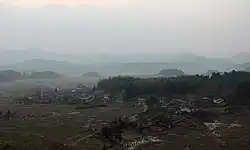Jinxi County
Jinxi County (simplified Chinese: 金溪县; traditional Chinese: 金溪縣; pinyin: Jīnxī Xiàn) is a county of Jiangxi province in the People's Republic of China. It is under the jurisdiction of the prefecture-level city of Fuzhou.
Jinxi County
金溪县 Kinki; Chinchi | |
|---|---|
| Jinxy County | |
 | |
 | |
| Coordinates: 27°54′N 116°45′E | |
| Country | People's Republic of China |
| Province | Jiangxi |
| Prefecture-level city | Fuzhou |
| Area | |
| • Total | 1,353 km2 (522 sq mi) |
| Population (2019) | |
| • Total | 306,700 |
| • Density | 230/km2 (590/sq mi) |
| Time zone | UTC+8 (China Standard) |
| Postal Code | 344800 |
Jinxi is the hometown of Lu Xiangshan (陆象山), a famous educator and thinker in the Southern Song Dynasty. He was highly honored in Chinese history as well as one of China's top ten thinkers. Jinxi has nurtured many famous figures, including Wei Su (危素), a famous historian in the Yuan Dynasty, Gong Tingxian (龚廷贤), a great medical scientist in the Ming Dynasty and Cai Shangxiang (蔡上翔), an outstanding scholar in the Qing Dynasty. Zhou Jianping (周建屏), the commander of the Red Tenth Army and one of the founders of Mingzhegan Revolution Base, also came from Jinxi. It has boasted two zhuangyuan, three bangyan and 242 jinshi since Jinxi County was founded.
Jinxi is the core zone of Linchuan culture as well as part and parcel of Gan culture. Jinxi County was founded in the fifth year of Chunhua of the Northern Song Dynasty (994 CE). Renowned for its important silver smelting site in the Tang Dynasty, the output of gold and silver in the ancient time and the golden streams running through the mountains, it was named Jinxi (golden stream). Some silver smelting relic sites and relevant inscriptions which were the earliest physically written record in ancient China's mining and metallurgy have still remained in the county. It used to be an important pottery and porcelain production base in the Song Dynasty, so a folk saying goes, "First Xiaopi Kiln, then Jingdezhen."
Administrative divisions
In the present, Jinxi County has 7 towns and 6 townships.[1]
- 7 towns
|
|
- 6 townships
|
|
Demographics
The population of the district was 605,100 as of 2010.[2]
Climate
| Climate data for Jinxi (1981−2010) | |||||||||||||
|---|---|---|---|---|---|---|---|---|---|---|---|---|---|
| Month | Jan | Feb | Mar | Apr | May | Jun | Jul | Aug | Sep | Oct | Nov | Dec | Year |
| Record high °C (°F) | 27.2 (81.0) |
29.2 (84.6) |
33.4 (92.1) |
35.1 (95.2) |
36.0 (96.8) |
37.5 (99.5) |
41.7 (107.1) |
42.0 (107.6) |
39.5 (103.1) |
36.7 (98.1) |
32.9 (91.2) |
26.9 (80.4) |
42.0 (107.6) |
| Average high °C (°F) | 10.0 (50.0) |
12.6 (54.7) |
16.6 (61.9) |
23.1 (73.6) |
27.7 (81.9) |
30.4 (86.7) |
34.5 (94.1) |
33.9 (93.0) |
29.8 (85.6) |
24.6 (76.3) |
18.7 (65.7) |
13.0 (55.4) |
22.9 (73.2) |
| Daily mean °C (°F) | 5.9 (42.6) |
8.2 (46.8) |
12.0 (53.6) |
18.2 (64.8) |
22.9 (73.2) |
26.1 (79.0) |
29.6 (85.3) |
28.6 (83.5) |
24.8 (76.6) |
19.5 (67.1) |
13.7 (56.7) |
8.0 (46.4) |
18.1 (64.6) |
| Average low °C (°F) | 2.9 (37.2) |
5.2 (41.4) |
8.7 (47.7) |
14.5 (58.1) |
19.1 (66.4) |
22.6 (72.7) |
25.8 (78.4) |
24.7 (76.5) |
21.1 (70.0) |
15.6 (60.1) |
9.8 (49.6) |
4.2 (39.6) |
14.5 (58.1) |
| Record low °C (°F) | −6.0 (21.2) |
−7.0 (19.4) |
−2.4 (27.7) |
3.1 (37.6) |
9.4 (48.9) |
14.0 (57.2) |
19.2 (66.6) |
19.4 (66.9) |
13.5 (56.3) |
3.0 (37.4) |
−2.0 (28.4) |
−11.1 (12.0) |
−11.1 (12.0) |
| Average precipitation mm (inches) | 98.4 (3.87) |
123.7 (4.87) |
215.4 (8.48) |
247.1 (9.73) |
237.4 (9.35) |
304.6 (11.99) |
153.3 (6.04) |
124.4 (4.90) |
91.2 (3.59) |
60.8 (2.39) |
88.7 (3.49) |
62.6 (2.46) |
1,807.6 (71.16) |
| Average relative humidity (%) | 82 | 82 | 82 | 80 | 78 | 80 | 71 | 76 | 80 | 78 | 78 | 77 | 79 |
| Source: China Meteorological Data Service Center[3] | |||||||||||||
Notes and references
- "南京市-行政区划网 www.xzqh.org" (in Chinese). XZQH. Retrieved 2012-05-24.
- "江西十大文化古县-金溪县简介(2013年)". www.jinxi.gov.cn. Archived from the original on 2014-08-10.
- 中国地面气候标准值月值(1981-2010) (in Simplified Chinese). China Meteorological Data Service Center. Retrieved 16 August 2022.
External links
- (in Chinese) Government site Archived 2005-04-05 at the Wayback Machine - English version